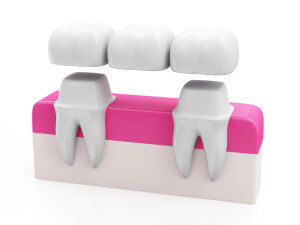 Patients dealing with tooth loss quickly discover that missing teeth are serious business. Not only do you feel the need to hide your smile when you speak with others (particularly if the tooth loss is near the front of your smile) but you may also struggle with daily comfort. For instance, just one missing tooth may cause chewing to become uncomfortable or difficult. Attempting to pronounce certain words can also become a challenge. If you’re missing one or a few teeth, consider the benefits of dental bridges, so you can begin your journey toward a complete, beautiful smile.
Patients dealing with tooth loss quickly discover that missing teeth are serious business. Not only do you feel the need to hide your smile when you speak with others (particularly if the tooth loss is near the front of your smile) but you may also struggle with daily comfort. For instance, just one missing tooth may cause chewing to become uncomfortable or difficult. Attempting to pronounce certain words can also become a challenge. If you’re missing one or a few teeth, consider the benefits of dental bridges, so you can begin your journey toward a complete, beautiful smile.
Who Qualifies
A dental bridge is a tooth replacement solution that works for specific types of tooth loss patterns. If you’re looking for a way to replace more than three teeth or teeth separated by remaining natural teeth, you will not qualify for a bridge but you may qualify for a partial denture. Bridges are best suited to the following patients:
- Patients missing a single tooth
- Patients missing up to three teeth in a row
How A Bridge Works
A dental bridge is a single unit composed of multiple, connected artificial teeth. Here’s how it works:
- Each end of the bridge is made up of a dental crown. A crown is a single, artificial, hollow tooth.
- The artificial teeth that sit between the two end dental crowns are called pontics – they will rest in the open space in your smile, filling it in to “bridge the gap” from one side of the opening to the other. By filling the opening, your smile will appear complete.
- To place the bridge, we will rely on your anchor teeth for support. These are the pair of natural teeth that are separated by the open space in your smile. We will cement the dental crowns over these teeth for fixed, long-term wear.


